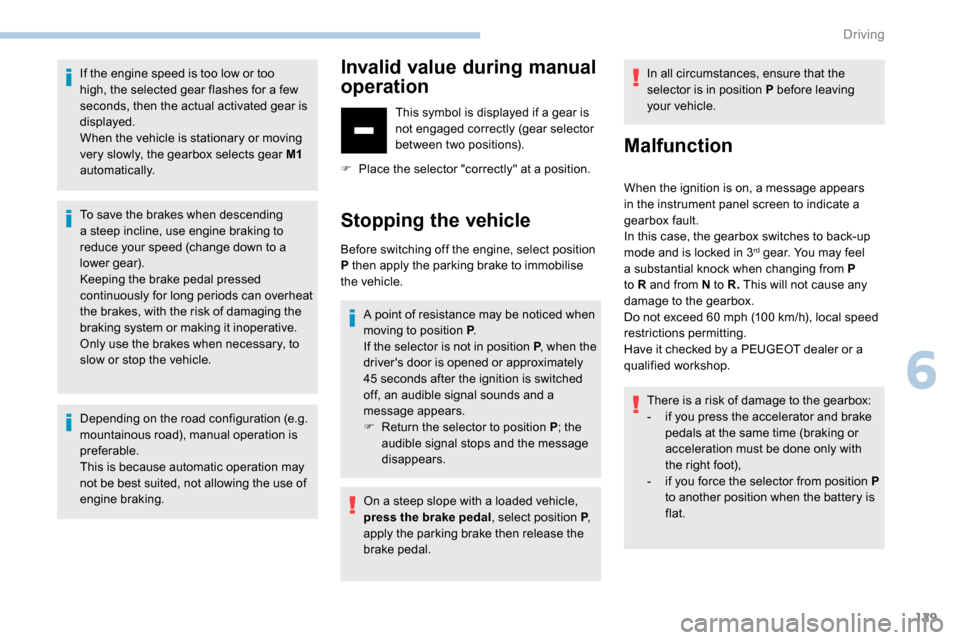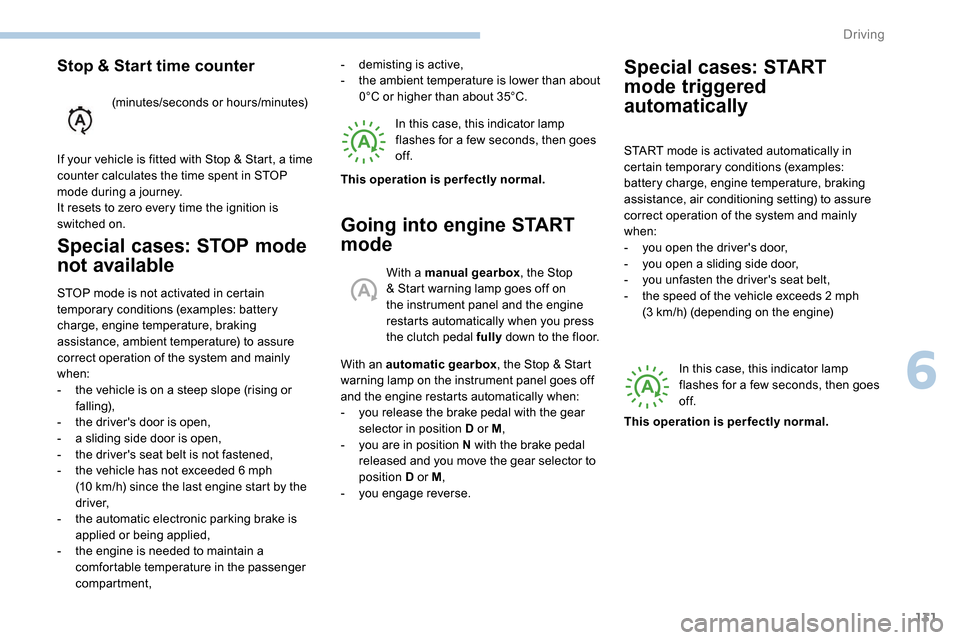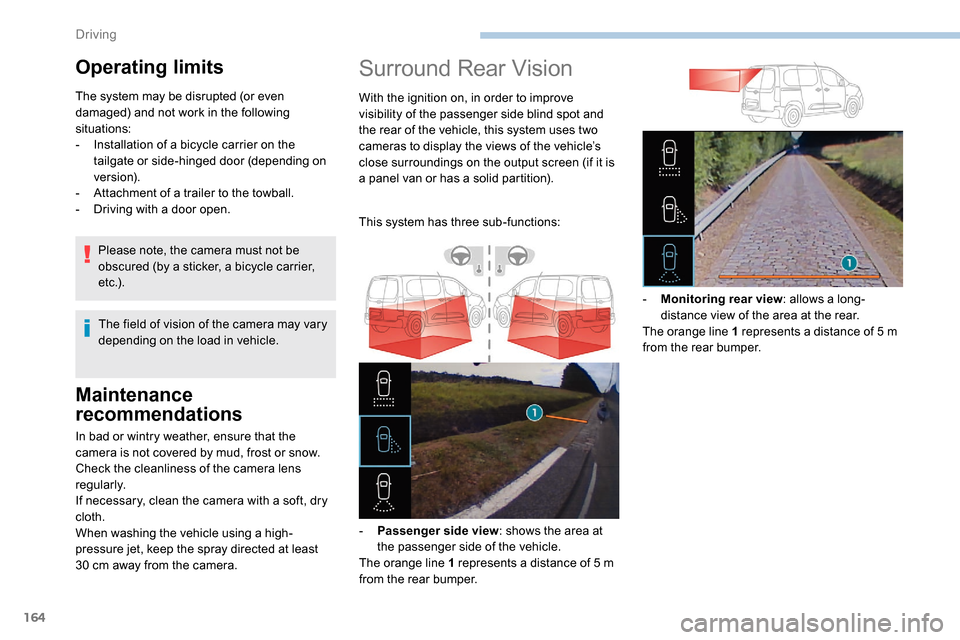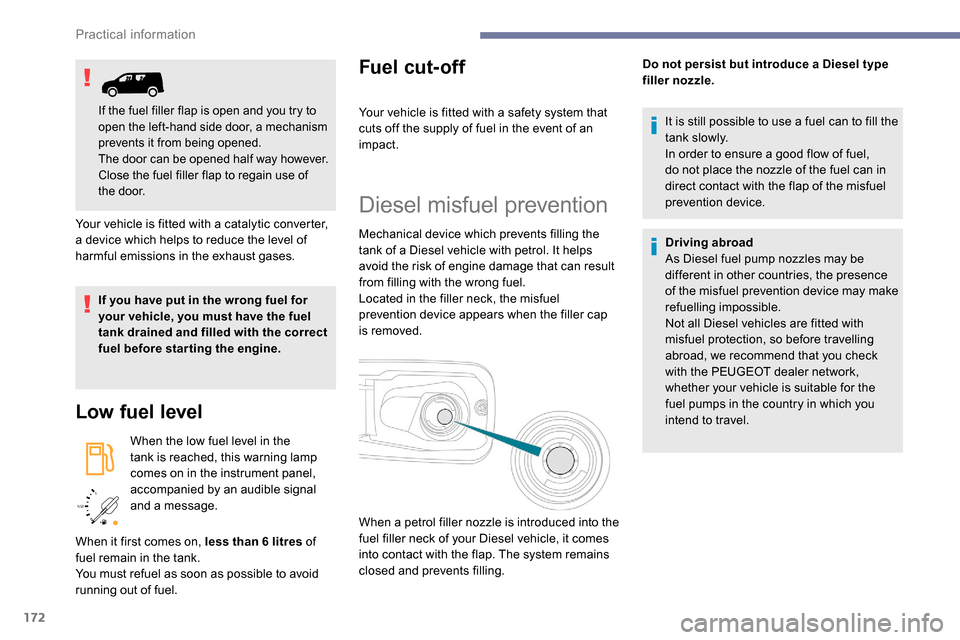2019 Peugeot Partner door panel
[x] Cancel search: door panelPage 127 of 312

125
Do not leave the vehicle while it is being
held temporarily by hill start assist.
If you need to leave the vehicle with the
engine running, apply the parking brake
manually then ensure that the parking
brake warning lamp lights up fixed on the
instrument panel.
Malfunction
- certain slope conditions are met,
- t he driver’s door is closed.
Uphill , with the vehicle stationary, the vehicle
is held for a short time when you release the
brake pedal.
With a manual gearbox , if you are in first gear
or in neutral.
With an automatic gearbox , if you are in
position D or M . Downhill
, with the vehicle stationary and
reverse gear engaged, the vehicle is held for a
short time when you release the brake pedal.
If a fault in the system occurs, these warning
lamps come on.
Contact a PEUGEOT dealer or a qualified
workshop to have the system checked.5-speed manual gearbox
Engaging reverse gear
Only engage reverse gear when the vehicle
is stationary with the engine at idle.
As a safety precaution and to facilitate
starting of the engine:
-
a
lways select neutral,
-
p
ress the clutch pedal.
F
W
ith the clutch pedal fully down, you must
place the gear lever in neutral.
F
M
ove the gear lever to the right, then pull it
back.
6
Driving
Page 130 of 312

128
Automatic operation
F Select position D for automatic
changing of the six gears.
Never select position N while the vehicle
is moving.
Never select position P or R unless the
vehicle is completely stationary.
Temporary manual control
of gear changes
You can temporarily take over control of gear
changes using the “ +” and “ -” steering mounted
controls. If the engine speed allows, the gear
change is carried out.
This function allows you to anticipate certain
situations, such as overtaking another vehicle
or approaching a bend in the road.
After a few moments with no action on the
control paddles, the gearbox returns to
automatic operation.
Self-sufficient traction (moving
without using the accelerator)
This function facilitates manoeuvring of the
vehicle at low speed (when parking, in traffic
jams, etc.).
With the engine at idle, parking brake released
and position D , M or R selected, the vehicle
moves
as soon as you take your foot off
the brake pedal (even without pressing the
accelerator).
As a safety measure (children on board),
never leave the vehicle with the engine
running and the doors closed.
The gearbox then operates in auto-adaptive
mode, without any inter vention on the part
of the driver. It continuously selects the most
suitable gear according to the style of driving,
the profile of the road and the load in the
vehicle.
For maximum acceleration without
touching the selector, press the
accelerator fully (kick-down). The
gearbox changes down automatically
or holds the gear selected until the
maximum engine speed is reached.
When braking, the gearbox changes down
automatically to provide effective engine
braking.
For better safety, the gearbox will not shift up if
you release the accelerator sharply.
Manual operation
F With the selector in position D ,
press button M for sequential
changing of the six gears.
The indicator lamp for the button goes off. In manual mode, it is not necessary
to release the accelerator pedal when
changing gear.
It is only possible to change from one gear
to another if the vehicle speed and engine
speed permit.
The indicator lamp for the button comes on.
F
O
perate the " +" or " -" steering mounted
controls.
M appears and the gears engaged
appear in succession in the
instrument panel.
F
I
t is possible to return to
automatic operation at any time
by pressing button M again.
Driving
Page 131 of 312

129
If the engine speed is too low or too
high, the selected gear flashes for a few
seconds, then the actual activated gear is
displayed.
When the vehicle is stationary or moving
very slowly, the gearbox selects gear M1
automatically.
To save the brakes when descending
a steep incline, use engine braking to
reduce your speed (change down to a
lower gear).
Keeping the brake pedal pressed
continuously for long periods can overheat
the brakes, with the risk of damaging the
braking system or making it inoperative.
Only use the brakes when necessary, to
slow or stop the vehicle.
Depending on the road configuration (e.g.
mountainous road), manual operation is
preferable.
This is because automatic operation may
not be best suited, not allowing the use of
engine braking.Invalid value during manual
operation
This symbol is displayed if a gear is
not engaged correctly (gear selector
between two positions).
F
P
lace the selector "correctly" at a position.
Stopping the vehicle
Before switching off the engine, select position
P then apply the parking brake to immobilise
the vehicle. A point of resistance may be noticed when
moving to position P .
If the selector is not in position P , when the
driver's door is opened or approximately
45
seconds after the ignition is switched
off, an audible signal sounds and a
message appears.
F
R
eturn the selector to position P ; the
audible signal stops and the message
disappears.
On a steep slope with a loaded vehicle,
press the brake pedal , select position P,
apply the parking brake then release the
brake pedal. In all circumstances, ensure that the
selector is in position P before leaving
your vehicle.
Malfunction
When the ignition is on, a message appears
in the instrument panel screen to indicate a
gearbox fault.
In this case, the gearbox switches to back-up
mode and is locked in 3
rd gear. You may feel
a substantial knock when changing from P
to R and from N to R. This will not cause any
damage to the gearbox.
Do not exceed 60
mph (100 km/h), local speed
restrictions permitting.
Have it checked by a PEUGEOT dealer or a
qualified workshop.
There is a risk of damage to the gearbox:
-
i
f you press the accelerator and brake
pedals at the same time (braking or
acceleration must be done only with
the right foot),
-
i
f you force the selector from position P
to another position when the battery is
flat.
6
Driving
Page 133 of 312

131
Special cases: STOP mode
not available
STOP mode is not activated in certain
temporary conditions (examples: battery
charge, engine temperature, braking
assistance, ambient temperature) to assure
correct operation of the system and mainly
when:
-
t
he vehicle is on a steep slope (rising or
falling),
-
t
he driver's door is open,
-
a s
liding side door is open,
-
t
he driver's seat belt is not fastened,
-
t
he vehicle has not exceeded 6 mph
(10
km/h) since the last engine start by the
driver,
-
t
he automatic electronic parking brake is
applied or being applied,
-
t
he engine is needed to maintain a
comfortable temperature in the passenger
compartment, In this case, this indicator lamp
flashes for a few seconds, then goes
of f.
Going into engine START
mode
With a manual gearbox
, the Stop
& Start warning lamp goes off on
the instrument panel and the engine
restarts automatically when you press
the clutch pedal fully down to the floor.
With an automatic gearbox , the Stop & Start
warning lamp on the instrument panel goes off
and the engine restarts automatically when:
-
y
ou release the brake pedal with the gear
selector in position D or M ,
-
y
ou are in position N with the brake pedal
released and you move the gear selector to
position D or M,
-
y
ou engage reverse.
-
d
emisting is active,
-
t
he ambient temperature is lower than about
0°C or higher than about 35°C.
This operation is perfectly normal.
Stop & Start time counter
(minutes/seconds or hours/minutes)
If your vehicle is fitted with Stop & Start, a time
counter calculates the time spent in STOP
mode during a journey.
It resets to zero every time the ignition is
switched on.
Special cases: START
mode triggered
automatically
START mode is activated automatically in
certain temporary conditions (examples:
battery charge, engine temperature, braking
assistance, air conditioning setting) to assure
correct operation of the system and mainly
when:
-
y
ou open the driver's door,
-
y
ou open a sliding side door,
-
y
ou unfasten the driver's seat belt,
-
t
he speed of the vehicle exceeds 2 mph
(3
km/h) (depending on the engine)In this case, this indicator lamp
flashes for a few seconds, then goes
of f.
This operation is perfectly normal.
6
Driving
Page 160 of 312

158
Activation/Deactivation
Activation or deactivation is set via
the vehicle configuration menu.
The system state remains in memory
when the ignition is switched off.
The system is automatically deactivated
when towing with a towbar approved by
P E U G E O T.
Malfunction
The system may suffer temporary
interference in certain weather conditions
(rain, hail, etc.).
In particular, driving on a wet sur face
or moving from a dry area to a wet area
can cause false alerts (for example, the
presence of a fog of water droplets in
the blind spot angle is interpreted as a
vehicle).
In bad or wintry weather, ensure that the
sensors are not covered by mud, ice or
snow.
Take care not to cover the warning zone in
the door mirrors or the detection zones on
the front and rear bumpers with adhesive
labels or other objects; they may hamper
correct operation of the system.
-
w
hen overtaking or being overtaken by a
very long vehicle (lorry, bus, etc.) which is
both in the rear blind spot and present in the
driver’s front field of vision,
-
i
n very heavy traffic: vehicles detected in
front and behind are confused with a lorry or
a stationary object,
-
w
hen overtaking quickly. If a fault occurs, this warning lamp
comes on in the instrument panel,
accompanied by a message.
Contact a PEUGEOT dealer or a qualified
workshop to have the system checked. High-pressure jet wash
When washing your vehicle, keep the
lance at least 30
cm away from the
sensors.
Driving
Page 166 of 312

164
Maintenance
recommendations
In bad or wintry weather, ensure that the
camera is not covered by mud, frost or snow.
Check the cleanliness of the camera lens
regularly.
If necessary, clean the camera with a soft, dry
cloth.
When washing the vehicle using a high-
pressure jet, keep the spray directed at least
30 cm away from the camera.
Surround Rear Vision
With the ignition on, in order to improve
visibility of the passenger side blind spot and
the rear of the vehicle, this system uses two
cameras to display the views of the vehicle’s
close surroundings on the output screen (if it is
a panel van or has a solid partition).
This system has three sub-functions:
-
P
assenger side view : shows the area at
the passenger side of the vehicle.
The orange line 1 represents a distance of 5
m
from the rear bumper. -
M
onitoring rear view: allows a long-
distance view of the area at the rear.
The orange line 1 represents a distance of 5
m
from the rear bumper.
Operating limits
The system may be disrupted (or even
damaged) and not work in the following
situations:
-
I
nstallation of a bicycle carrier on the
tailgate or side-hinged door (depending on
ve r s i o n).
-
A
ttachment of a trailer to the towball.
-
D
riving with a door open.
The field of vision of the camera may vary
depending on the load in vehicle.
Please note, the camera must not be
obscured (by a sticker, a bicycle carrier,
e t c .) .
Driving
Page 174 of 312

172
/2
1 1
Your vehicle is fitted with a catalytic converter,
a device which helps to reduce the level of
harmful emissions in the exhaust gases.
If you have put in the wrong fuel for
your vehicle, you must have the fuel
tank drained and filled with the correct
fuel before star ting the engine.
Low fuel level
When the low fuel level in the
tank is reached, this warning lamp
comes on in the instrument panel,
accompanied by an audible signal
and a message.
Fuel cut- of f
When it first comes on, less than 6 litres of
f uel remain in the tank.
You must refuel as soon as possible to avoid
running out of fuel. Your vehicle is fitted with a safety system that
cuts off the supply of fuel in the event of an
impact.
Diesel misfuel prevention
Mechanical device which prevents filling the
tank of a Diesel vehicle with petrol. It helps
avoid the risk of engine damage that can result
from filling with the wrong fuel.
Located in the filler neck, the misfuel
prevention device appears when the filler cap
is removed.
It is still possible to use a fuel can to fill the
t a n k s l ow l y.
In order to ensure a good flow of fuel,
do not place the nozzle of the fuel can in
direct contact with the flap of the misfuel
prevention device.
Driving abroad
As Diesel fuel pump nozzles may be
different in other countries, the presence
of the misfuel prevention device may make
refuelling impossible.
Not all Diesel vehicles are fitted with
misfuel protection, so before travelling
abroad, we recommend that you check
with the PEUGEOT dealer network,
whether your vehicle is suitable for the
fuel pumps in the country in which you
intend to travel.
When a petrol filler nozzle is introduced into the
fuel filler neck of your Diesel vehicle, it comes
into contact with the flap. The system remains
closed and prevents filling. Do not persist but introduce a Diesel type
filler nozzle.
If the fuel filler flap is open and you try to
open the left-hand side door, a mechanism
prevents it from being opened.
The door can be opened half way however.
Close the fuel filler flap to regain use of
the door.
Practical information
Page 302 of 312

220
Cruise control, dynamic with Stop function ................................ 13 6, 142-145 , 148
Cup holder
....................................................... 64
DDAB (Digital Audio Broadcasting) -
Digital radio ........................................ 6 -7, 8, 24
Date (setting)
....................................... 35, 17 , 32
Daytime running lamps
.....................85, 87 , 198
Deactivating the passenger airbag
.......10 6, 11 0
Deactivation of DSC (ESC)
.............................99
Deadlocking
.................................................... 43
Defrosting
.................................................. 58, 78
Demisting
........................................................ 78
Demisting, rear
.......................................... 57, 79
Demisting, rear screen
.............................57, 79
Diesel
..................................................... 213 -216
Dimensions
..............................
.....................208
Dipstick
................
............................30, 179 -18 0
Direction indicators
...................86 - 87, 198, 19 9
Display screen, instrument panel
...........29, 13 0
Distance Alert
.................................. 18, 15 0 -151
Doors, side-hinged
................................... 42
- 43
Driver’s attention warning
.............................159
Driving
........................................................... 115
Driving abroad ................................................. 86
Dynamic stability control (DSC)
................................. 20, 97- 9 9 , 101-102
EEarth point, remote ....................................... 17 8
EBFD ................ ............................................... 98
Economy mode
............................................. 17
6
Electric windows
............................................. 55
Electronic brake force distribution (EBFD) .....9 7- 9 8Emergency braking assistance (EBA) .......9 7- 9 8
Emergency call ............................................... 96
Emergency warning lamps
.............................97
Emissions control system, SCR
...................183
Energy economy mode
................................. 17
6
Engine
.................................................... 211-216
Engine compartment
.................................... 17
8
Engine, Diesel
..................18, 170 , 187, 213 -216
Engine, petrol
......................... 17
0, 178 , 211-212
Engines
.................................................. 210 -216
Engine self-diagnosis
..................................... 17
E
nvironment
.............................................. 46, 82
ESC (electronic stability control)
....................97
E
xtended traffic sign recognition
..................13 6
FFatigue detection .......................................... 159
Filling the AdBlue® tank ................................ 185
Filling the fuel tank ................................. 170 -172
Filter, air
........................................................ 181
Filter, Diesel fuel
........................................... 179
Filter, oil
................
......................................... 182
Filter, particle
................................... 19, 181-182
Filter, passenger compartment
..................... 181
Finisher
......................................................... 195
Fitting a wheel
........................................ 193 -195
Fitting roof bars
............................................. 17 7
Fittings, interior
............................................... 64
F
lap, fuel filler
......................................... 171-172
Flap, removable
..............................
...........70 -71
Flashing indicators
............................ 86 - 87, 19 9
Foglamp, rear
................................... 25, 85 , 19 9
Foglamps, front
........................... 85, 90 -91 , 19 9
Foglamps, rear
................................................ 85
F
olding the rear seats
............................... 63-64
Frequency (radio)
...................................... 23 -24
Fuel................................................................ 170
Fuel tank ........................................................ 171
Fusebox, engine compartment
.....................203
Fuses
..................................................... 20
1-203
GGauge, fuel............................................. 171-172
Gearbox, automatic ...............11 6, 125-132 , 182
Gearbox, electronic
...............................13 0 -132
Gearbox, manual
...........125 -126 , 13 0 -132 , 182
Gear lever, automatic gearbox
..............126 -12 9
Gear lever, manual gearbox
..................125 -126
Gear shift indicator ~ Gear efficiency indicator
...................................................... 13 0
Glove box
........................................................ 64
G . P. S .
.............................................................. 14
HHazard warning lamps ....................................97Hazard warning lamps, automatic operation ......97headlamp adjustment ..................................... 91
Headlamp adjustment ..................................... 91
Headlamp beam height
................................... 91
H
eadlamps, automatic illumination
..........86-88
Headlamps, dipped beam
.................27, 85 , 197
Headlamps, halogen
..................................... 19 6
Headlamps, intelligent beam
......27, 88-90 , 15 8
Headlamps, main beam
....................27, 85 , 198
Head restraints ................................................ 60
Head restraints, front
...................................... 64
Head restraints, rear
.................................63-64
Heating
.......................................... 75,
79 - 81, 83
Heating, additional
..............................53, 79 - 81
Heating, programmable
......................53, 79 - 81
Alphabetical index